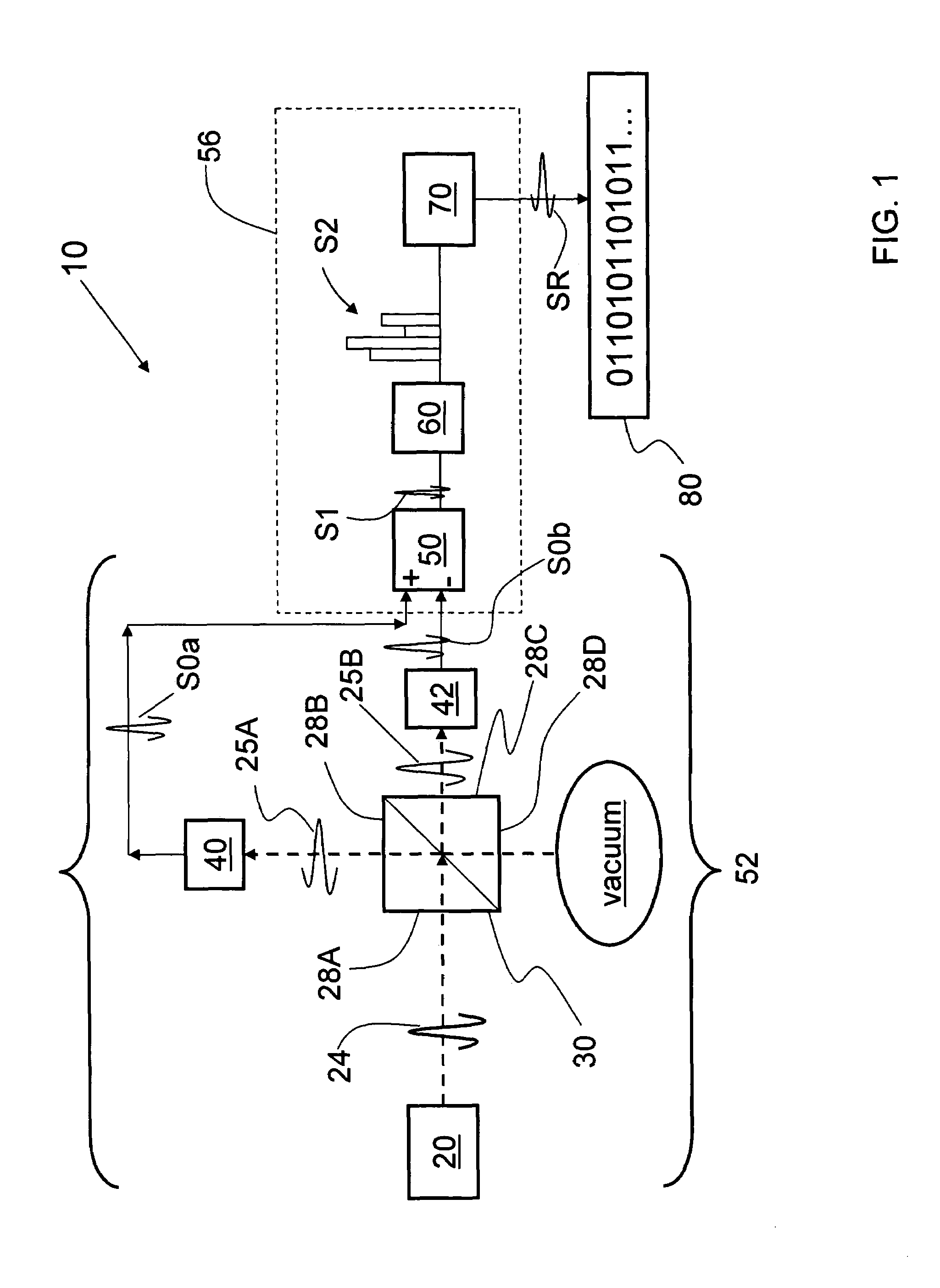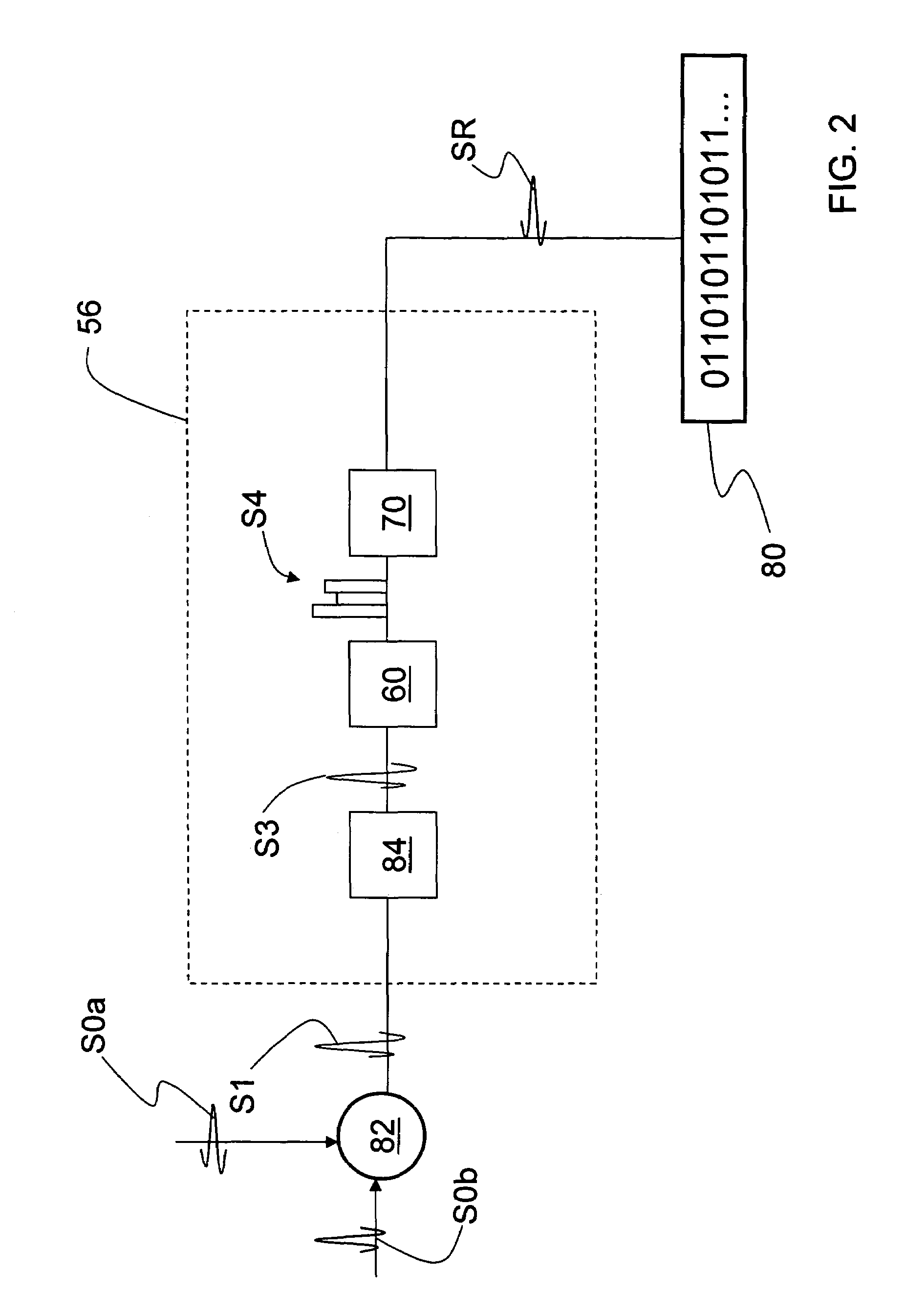Quantum noise random number generator
a random number generator and quantum noise technology, applied in the field of random number generation, can solve the problems of generating random numbers randomly encoding photons, current optical quantum random number generators are by no means the best possible, and the latter is expensive and relatively slow (100 khz)
- Summary
- Abstract
- Description
- Claims
- Application Information
AI Technical Summary
Problems solved by technology
Method used
Image
Examples
first example embodiment
[0021]FIG. 1 is a schematic diagram of a first example embodiment a quantum-noise TRNG system 10 according to the present invention. System 10 includes a laser source 20 adapted to emit a light signal 24, which may be a continuous beam or pulses of light. System 10 also includes a 50 / 50 beamsplitter 30 that has four ports 28A, 28B, 28C and 28D. Beamsplitter 30 is arranged to receive light signal 24 at port 28A. System 10 also includes two photodetectors (e.g., photodiodes) 40 and 42 respectively arranged so as to be in optical communication with corresponding ports 28B and 28C. Port 28D is “open” or “dark,” meaning that the port is subject to vacuum fluctuations. Port 28D is thus shown as connected to a vacuum.
[0022]Photodetectors 40 and 42 are electrically connected to a differential transimpedance amplifier (TIA) 50. The laser source 20, beamsplitter 30, detectors 40 and 42 and the differential TIA 50 constitute a homodyne quantum noise source 52.
[0023]In the example embodiment il...
second example embodiment
[0033]FIG. 2 is a close-up schematic diagram of the processing electronics 56 associated with a second example embodiment of system 10. In this second embodiment, photodetectors 40 and 42 (FIG. 1) are electrically connected to a subtractor 82. As the term is used herein, “subtractor” means any device that can receive two signals and subtract one from the other to create a difference signal. The laser source 20, beamsplitter 30, detectors 40 and 42 and subtractor 82 constitute homodyne quantum noise source 52.
[0034]Subtractor 82 is electrically connected to processing electronics 56, which includes electrically coupled to one another in sequence a TIA 84, an ADC 60 and transformation electronics 70. Thus, subtractor 82 and TIA 84 function much in the same manner as the single differential TIA 50, though the single differential TIA embodiment typically provides for better bandwidth and better immunity to external noise.
[0035]In the operation of the second embodiment of system 10, subt...
third example embodiment
[0036]FIG. 3 is a close-up schematic diagram of the processing electronics 56 associated with a second example embodiment of system 10. Processing electronics 56 includes a TIA 84 and an ADC 60 between detector 40 and subtractor 82, and a TIA 84 and ADC 60 between detector 42 and subtractor 82. This third embodiment operates in a manner similar to that of the system of FIG. 2, except that the placement of TIAs 84 and ADCs 60 result in the creation of respective analog voltage signals S3a and S3b (“analog photovoltages”) from TIAs 84 and respective digital voltage signals S5a and S5b (“digital photovoltages”) from ADTs 60. Signals S5a and S5b are then digitally subtracted at subtractor 82. This produces a digital voltage difference signal S6, which is received and processed by transformation electronics 70 to create random number signal SR corresponding to random number sequence 80.
QKD System
[0037]FIG. 4 is a schematic diagram of an example embodiment of a folded QKD system 200 that ...
PUM
 Login to View More
Login to View More Abstract
Description
Claims
Application Information
 Login to View More
Login to View More - R&D
- Intellectual Property
- Life Sciences
- Materials
- Tech Scout
- Unparalleled Data Quality
- Higher Quality Content
- 60% Fewer Hallucinations
Browse by: Latest US Patents, China's latest patents, Technical Efficacy Thesaurus, Application Domain, Technology Topic, Popular Technical Reports.
© 2025 PatSnap. All rights reserved.Legal|Privacy policy|Modern Slavery Act Transparency Statement|Sitemap|About US| Contact US: help@patsnap.com



